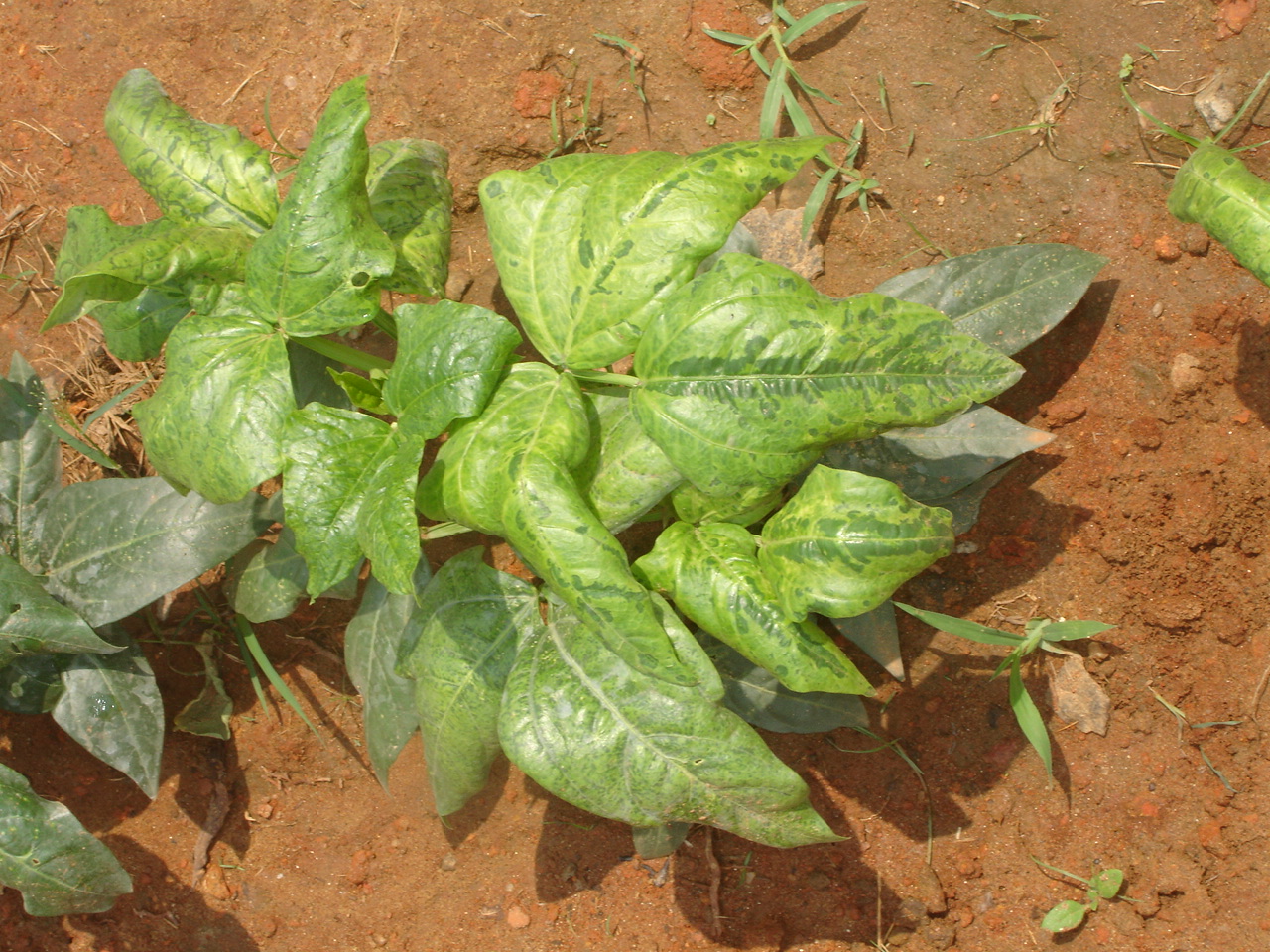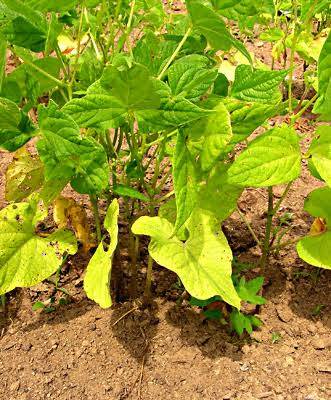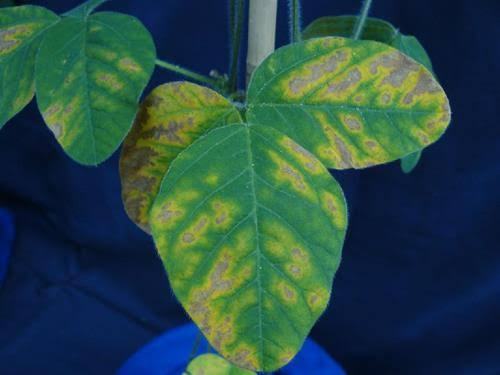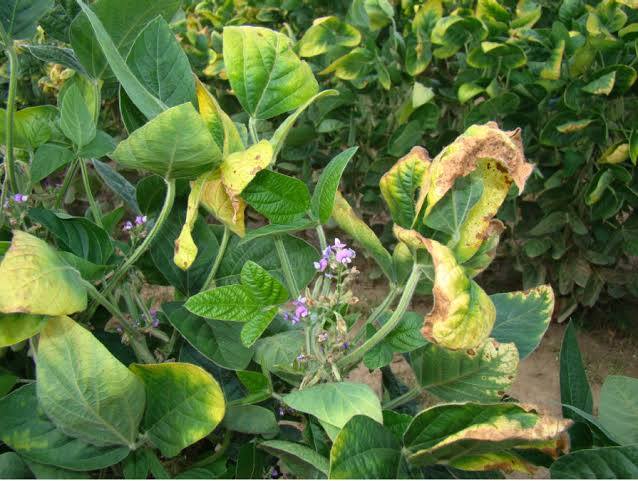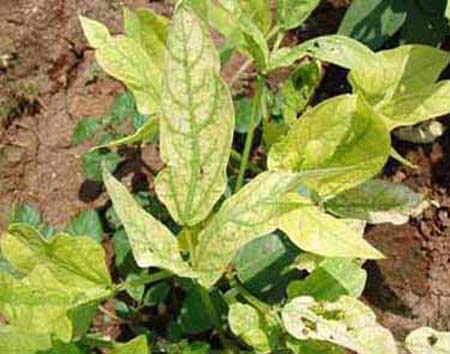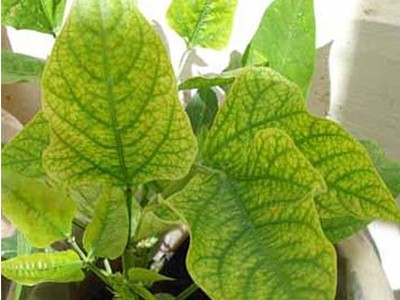Aphids (Aphis craccivora)
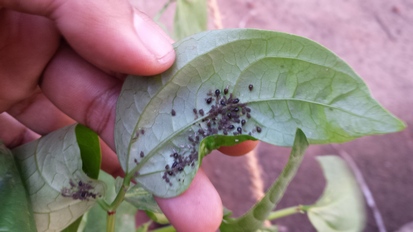
|
Importance of the
problem |
Aphids are significant pests in cowpea cultivation, causing direct damage by sap-sucking and indirect damage by transmitting viral diseases, leading to substantial yield losses. |
|
Common signs and
symptoms |
- Curling and distortion of young leaves
- Sticky honeydew secretion on plant surfaces
- Presence of sooty mold on leaves
- Stunted plant growth and reduced vigor
- Clusters of small, soft-bodied insects on tender parts
|
|
Problems with similar
symptoms |
- Thrips – Both cause leaf curling and distortion in young leaves
- Whiteflies – Both produce honeydew leading to sooty mold
- Cowpea Mosaic Virus – Transmitted by aphids; similar leaf mottling
|
|
Causal organism and
their spread |
The cowpea aphid (Aphis craccivora) is a small, sap-sucking insect that reproduces rapidly. It spreads through winged adults that migrate between plants and fields, facilitating rapid colonization. |
|
Mechanism of damage |
Aphids feed by inserting their stylets into phloem tissues, extracting sap, which weakens the plant. Their feeding can cause leaf curling and distortion. Additionally, they excrete honeydew, promoting sooty mold growth, and act as vectors for viruses like the cowpea mosaic virus. |
|
Ideal management
strategy |
- Monitor fields regularly for early aphid detection
- Encourage natural predators like lady beetles
- Use reflective mulches to deter aphid colonization
- Apply neem-based insecticides as a preventive measure
- Insecticide: Imidacloprid 17.8% SL at 0.3 ml/liter water
- Insecticide: Thiamethoxam 25% WG at 0.2 g/liter water
|
|
References |
1. CABI Compendium: Aphis craccivora (groundnut aphid) IJCMAS+2CABI Digital Library+2CABI Digital Library+2.
|
Thrips (Megalurothrips sjostedti)
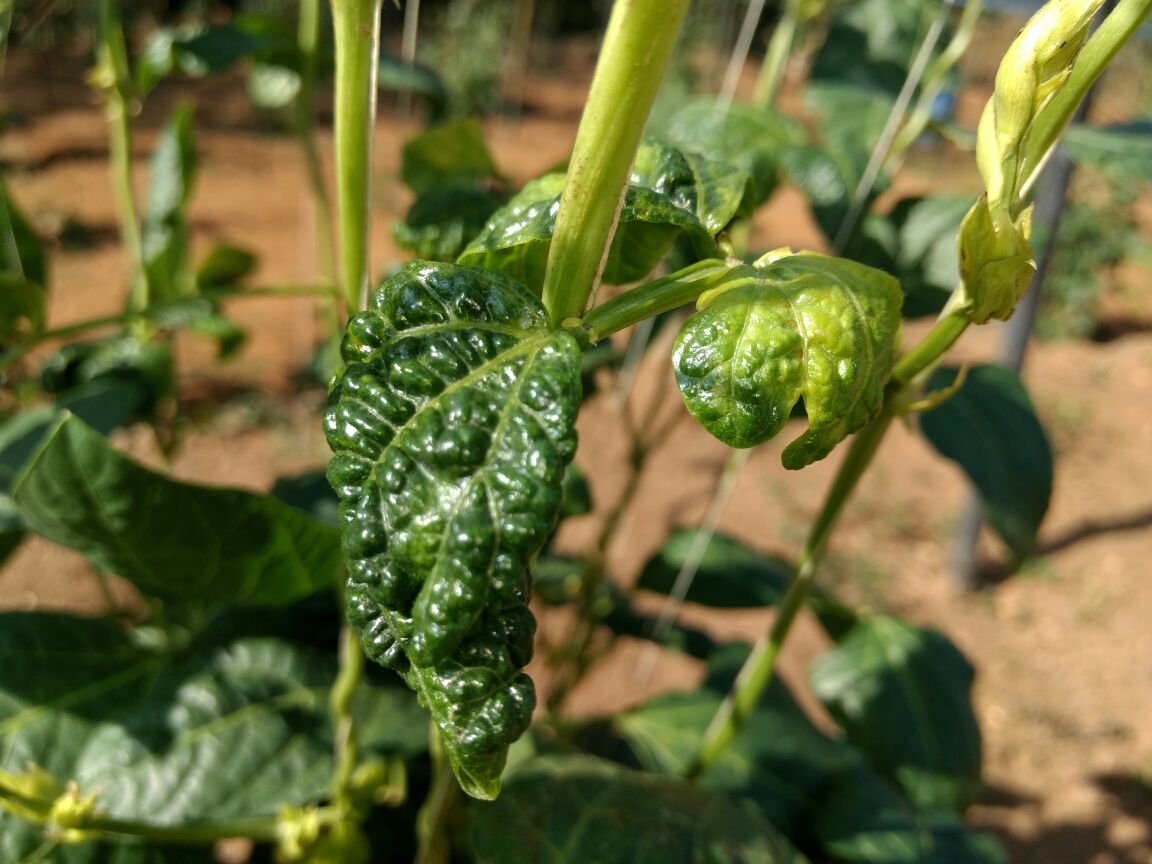
|
Importance of the
problem |
Thrips parvispinus is an emerging and destructive pest of cowpea and various horticultural crops. In cowpea, it inflicts significant economic damage, especially during flowering, by attacking floral tissues and potentially transmitting viruses like Cowpea Chlorotic Mottle Virus. Infestations can severely reduce pod set and seed yield. |
|
Common signs and
symptoms |
- Silvery or bronzed streaks on leaves and flower parts
- Premature bud and flower drop
- Deformed, discolored, or scarred flowers
- Poor pod development and reduced seed set
- Presence of black fecal spots on leaves and floral parts
|
|
Problems with similar
symptoms |
- Aphids – Also cause curling in young foliage and transmit viruses
- Herbicide Injury – Can mimic leaf and bud distortion
- Cowpea Mosaic Virus – Causes flower abortion and leaf deformities similar to thrips damage
|
|
Causal organism and
their spread |
Thrips parvispinus is a small, dark thrips species with fringed wings. It spreads through wind dispersal, infested planting material, and contaminated tools or clothing. It reproduces rapidly under warm, dry conditions and thrives in flower-rich environments. |
|
Mechanism of damage |
This thrips species feeds by rasping and sucking the contents of plant epidermal cells, leading to silvering, deformation, and tissue necrosis. It targets buds and floral tissues, resulting in flower abortion and poor seed set. Feeding damage also facilitates the entry and spread of viral pathogens. |
|
Ideal management
strategy |
- Remove weeds and crop residues that harbor thrips
- Use early planting to avoid peak thrips pressure
- Practice intercropping with non-host species (e.g., maize)
- Apply neem seed kernel extract (5%) at regular intervals
- Insecticide: Fipronil 5% SC at 1 ml/liter water
- Insecticide: Spinosad 45% SC at 0.3 ml/liter water
|
|
References |
1. CABI Compendium: Thrips parvispinus.
2. IITA Reports on Thrips Pests of Legumes.
|
Pod Borer (Helicoverpa armigera, Maruca vitrata, Etiella zinckenella)

|
Importance of the
problem |
Among the three, Maruca vitrata is the most destructive pod borer in cowpea, capable of causing up to 80% yield loss under severe infestations by attacking flower buds, flowers, and pods. |
|
Common signs and
symptoms |
- Maruca vitrata: Webbing of flower buds and leaves, boreholes on buds and pods, drooping of floral parts, and frass near entry holes.
- Helicoverpa armigera: Large boreholes on pods, visible greenish larvae feeding externally before entering pods.
- Etiella zinckenella: Small entry holes near pod tips, internal seed feeding, and exit holes on mature pods.
- All three may show shriveling pods with larvae visible inside.
|
|
Problems with similar
symptoms |
- Other pod borers – similar internal damage
- Pod-sucking bugs – cause shriveled, malformed pods without boreholes
- Fungal pod rots – lead to discoloration and seed shriveling
- Cowpea weevil – post-harvest seed damage mimics internal feeding
|
|
Causal organism and
their spread |
Maruca vitrata, Helicoverpa armigera, and Etiella zinckenella are moth species. Adult moths lay eggs on flowers and pods; larvae feed internally. Spread occurs through adult moth flight and migration between host plants. |
|
Mechanism of damage |
Larvae feed on internal tissues of buds, flowers, and pods, causing webbing (mainly Maruca), seed damage, and pod abortion. This leads to significant yield reduction and poor seed quality. |
|
Ideal management
strategy |
- Plant early-maturing or resistant cowpea varieties
- Remove and destroy infested pods and webbed parts
- Intercrop with cereals (e.g., sorghum or maize) to deter spread
- Monitor with pheromone traps (Maruca-specific)
- Apply insecticides during flowering/podding stage:
- Emamectin benzoate 5% SG @ 0.4 g/liter of water
- Flubendiamide 20% WG @ 0.1 g/liter of water
|
|
References |
1. IITA Insect Pest Manual: Maruca vitrata.
2. CIBRC India: Approved Pesticides for Legume Crops.
|
Cowpea Weevil (Callosobruchus maculatus)
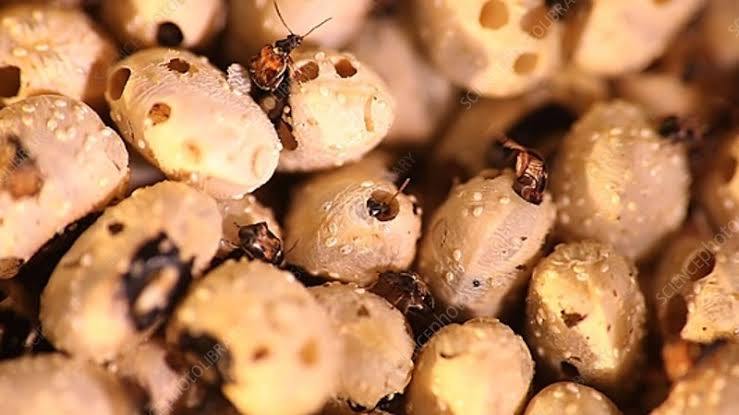
|
Importance of the
problem |
Cowpea weevil is a destructive post-harvest pest of stored cowpea seeds. It causes significant quantitative and qualitative losses, rendering grains unfit for consumption or sowing. |
|
Common signs and
symptoms |
- Round exit holes on stored seeds
- Presence of adult beetles in storage containers
- Hollow, brittle, or lightweight grains
- Powdery residue (frass) in seed storage
- Seed discoloration or deterioration
|
|
Problems with similar
symptoms |
- Maruca Pod Borer – Pre-harvest damage can be confused if infestation is internal
- Pod-sucking Bugs – Can also leave shriveled, empty seeds
- Storage Fungi – Seed damage in storage due to fungi may mimic insect injury
|
|
Causal organism and
their spread |
Callosobruchus maculatus is a bruchid beetle. Infestation starts in the field and continues during storage. Adult beetles lay eggs on seeds; larvae bore inside and feed within. |
|
Mechanism of damage |
Larvae penetrate seed coats and feed internally, reducing seed weight and viability. The damage continues unnoticed in storage until adult emergence, making the pest highly destructive. |
|
Ideal management
strategy |
- Use well-dried, undamaged seeds for storage
- Store in airtight containers or metal bins
- Treat seeds with neem oil or inert dusts
- Use triple-layer PICS bags for protection
- Insecticide: Aluminium phosphide tablets (fumigant) – use as per CIBRC label
- Maintain low moisture (<10%) in stored seeds
|
|
References |
1. ICRISAT Storage Pest Management Guide.
2. Central Insecticide Board & Registration Committee (CIBRC), India.
|
Leafhoppers (Empoasca spp.)
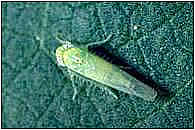
|
Importance of the
problem |
Leafhoppers are important sap-sucking pests of cowpea. They reduce plant vigor, impair photosynthesis, and act as vectors for certain plant pathogens, leading to reduced yields. |
|
Common signs and
symptoms |
- Yellowing or browning of leaf margins (hopper burn)
- Downward leaf curling and cupping
- Stunted growth and reduced tillering
- Presence of small, active green insects on leaves
- Premature drying of leaves in severe cases
|
|
Problems with similar
symptoms |
- Magnesium or Potassium Deficiency – Similar interveinal yellowing
- Aphids – Can cause curling and yellowing in early stages
- Cowpea Mosaic Virus – Can cause stunted growth and deformed leaves
|
|
Causal organism and
their spread |
Species like Empoasca fabae and Empoasca kerri are the primary pests. They reproduce rapidly and are dispersed by wind and plant-to-plant movement in fields. |
|
Mechanism of damage |
Leafhoppers feed by inserting their stylets into phloem and mesophyll tissues, removing sap and injecting toxic saliva. This disrupts cell function and causes the characteristic "hopper burn." |
|
Ideal management
strategy |
- Remove weeds that harbor leafhoppers
- Encourage predators like spiders and lacewings
- Use yellow sticky traps for monitoring and control
- Avoid excessive nitrogen that promotes soft foliage
- Insecticide: Imidacloprid 17.8% SL at 0.3 ml/liter water
- Insecticide: Thiamethoxam 25% WG at 0.2 g/liter water
|
|
References |
1. ICRISAT Legume Pest Management Manual.
2. Kerala Agricultural University Plant Protection Guidelines.
|
Whiteflies (Bemisia tabaci)

|
Importance of the
problem |
Whiteflies are major sap-sucking pests and virus vectors in cowpea. They cause direct feeding damage and spread viruses like Cowpea Mosaic Virus, significantly reducing yield and seed quality. |
|
Common signs and
symptoms |
- Yellowing and curling of upper leaves
- Sticky honeydew and black sooty mold on leaves
- Reduced plant vigor and stunted growth
- Visible white insects flying when disturbed
- Patchy field appearance due to uneven damage
|
|
Problems with similar
symptoms |
- Aphids – Also cause honeydew and black sooty mold
- Cowpea Mosaic Virus – Transmitted by whiteflies, causes similar foliar symptoms
- Iron Deficiency – Interveinal chlorosis may resemble virus infection caused by whiteflies
|
|
Causal organism and
their spread |
Bemisia tabaci is a highly polyphagous and mobile insect. It reproduces quickly, especially in warm, dry weather. Adults and nymphs suck sap and transmit viruses persistently. |
|
Mechanism of damage |
Whiteflies feed on phloem sap and excrete honeydew, promoting sooty mold that blocks photosynthesis. They are efficient vectors of plant viruses, causing secondary systemic damage. |
|
Ideal management
strategy |
- Remove weed hosts and volunteer plants regularly
- Install yellow sticky traps to monitor populations
- Encourage natural enemies like ladybird beetles
- Spray neem oil 3% for early-stage infestations
- Insecticide: Buprofezin 25% SC at 1.5 ml/liter water
- Insecticide: Thiamethoxam 25% WG at 0.2 g/liter water
|
|
References |
1. ICAR Handbook of Insect Pests of Pulses.
2. CIBRC (India) Insecticide Recommendations for Whitefly.
|
Pod-sucking Bugs (Clavigralla spp., Riptortus spp.)
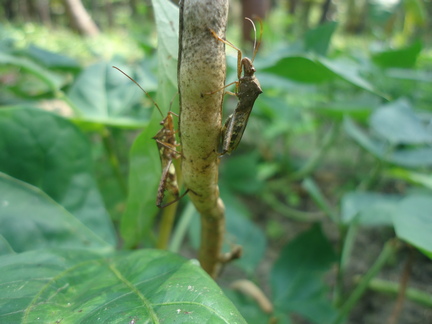
|
Importance of the
problem |
Pod-sucking bugs are serious pests of cowpea during pod formation and seed filling. They reduce seed quality and quantity, often causing shriveled and discolored seeds. |
|
Common signs and
symptoms |
- Brown sunken spots on green pods
- Deformed or shriveled seeds inside pods
- Sticky exudate on damaged pod areas
- Discolored and poorly filled pods
- Adult bugs visible on pods during podding stage
|
|
Problems with similar
symptoms |
- Maruca Pod Borer – Both cause shriveled and unfilled pods
- Cowpea Weevil – Seed damage can resemble field damage if pods crack
- Drought Stress – May also lead to pod shrinkage and abortion
|
|
Causal organism and
their spread |
Species such as Clavigralla tomentosicollis and Riptortus pedestris are responsible. These large piercing-sucking bugs migrate from alternate hosts and congregate during cowpea podding. |
|
Mechanism of damage |
Bugs insert needle-like mouthparts into developing pods and seeds, sucking out nutrients. Their feeding leads to shriveled, stained seeds and weak pods, impacting marketability and germination. |
|
Ideal management
strategy |
- Handpick and destroy adult bugs in early infestation
- Grow resistant or early-maturing cowpea varieties
- Harvest promptly to reduce bug feeding period
- Use light traps to monitor adult bug activity
- Insecticide: Thiamethoxam 25% WG at 0.2 g/liter water
- Insecticide: Acephate 75% SP at 1.5 g/liter water
|
|
References |
1. IITA Cowpea Pest Identification Guide.
2. CIBRC, India – Registered Insecticides for Pod Bugs.
|
Bacterial Blight (Xanthomonas axonopodis pv. vignicola)
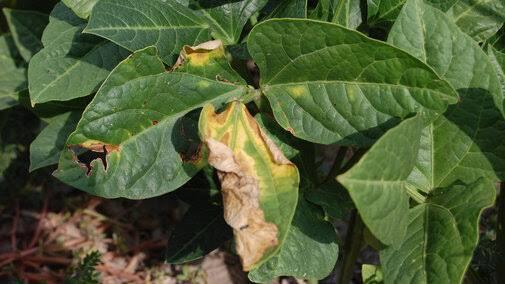
|
Importance of the
problem |
Bacterial blight is a major foliar disease of cowpea, affecting leaves, stems, and pods. It can cause significant yield loss, especially under warm and humid conditions. |
|
Common signs and
symptoms |
- Water-soaked spots on leaves turning brown
- Angular lesions with yellow halos on leaves
- Cracking and shriveling of infected pods
- Premature leaf drop and stem lesions
- Gummy exudates may appear on pods and stems
|
|
Problems with similar
symptoms |
- Cercospora Leaf Spot – Both cause brown lesions on leaves
- Anthracnose – May produce dark lesions on leaves and pods
- Herbicide Injury – Can cause sudden necrotic patches resembling disease spots
- Drought Stress – Leaf scorch symptoms might look like blight
|
|
Causal organism and
their spread |
Caused by the bacterium Xanthomonas axonopodis pv. vignicola. It spreads via infected seed, splashing rain, irrigation water, and mechanical injury during cultivation. |
|
Mechanism of damage |
The bacterium enters through natural openings or wounds, multiplying in intercellular spaces and producing toxins. It disrupts photosynthesis, kills tissue, and reduces pod formation. |
|
Ideal management
strategy |
- Use certified disease-free seed for sowing
- Treat seed with Streptocycline 100 ppm for 30 mins
- Practice crop rotation with non-host crops
- Avoid overhead irrigation in infected fields
- Spray Copper oxychloride 50% WP at 2.5 g/liter water
- Remove and burn infected plant debris after harvest
|
|
References |
1. Kerala Agricultural University Plant Disease Management Handbook.
2. ICAR Integrated Pest and Disease Management Guidelines.
|
Powdery Mildew (Erysiphe polygoni)

|
Importance of the
problem |
Powdery mildew is a widespread fungal disease of cowpea, reducing photosynthesis, plant vigor, and ultimately yield, especially under warm, dry, and humid conditions. |
|
Common signs and
symptoms |
- White powdery patches on leaf surfaces
- Infected leaves become yellow and dry up
- Symptoms start on older leaves and spread upward
- Affected pods may also show white patches
- Premature leaf fall in severe cases
|
|
Problems with similar
symptoms |
- Downy Mildew – Both produce fungal growth; differ in location (upper vs. lower leaf surface)
- Sooty Mold (from aphids/whiteflies) – Blackish mold may confuse with fungal coverage
- Dust or Chemical Residue – Can resemble powdery appearance of mildew
|
|
Causal organism and
their spread |
Caused by the fungus Erysiphe polygoni, which spreads via wind-borne conidia (asexual spores). It survives on plant debris and infects healthy tissue under favorable conditions. |
|
Mechanism of damage |
The fungus forms a superficial mycelial network on leaves and penetrates epidermal cells using haustoria. This reduces photosynthesis and leads to defoliation, poor pod setting, and reduced seed filling. |
|
Ideal management
strategy |
- Grow resistant cowpea varieties when available
- Avoid excessive nitrogen fertilization
- Remove and destroy infected plant debris
- Maintain field spacing for air circulation
- Fungicide: Wettable Sulphur 80% WP at 2 g/liter water
- Fungicide: Hexaconazole 5% EC at 2 ml/liter water
|
|
References |
1. ICAR Handbook on Pulse Diseases.
2. CIBRC Approved Fungicides for Powdery Mildew Control.
|
Downy Mildew (Phytophthora nicotianae var. nicotianae)

|
Importance of the
problem |
Downy mildew is a serious disease of cowpea, particularly under cool, humid conditions. It affects leaf health and pod formation, leading to significant yield losses in affected crops. |
|
Common signs and
symptoms |
- Yellow to pale green patches on upper leaf surface
- White to grayish fungal growth on lower leaf surface
- Leaves become curled, distorted, and necrotic
- Severely affected plants are stunted and weak
- Infected pods may develop sunken spots or rot
|
|
Problems with similar
symptoms |
- Powdery Mildew – Fungal symptoms, but on upper surface instead
- Nutrient Deficiency (Zinc/Iron) – Chlorosis may resemble mildew in early stages
- Bacterial Blight – Some leaf lesions may be misidentified as mildew damage
|
|
Causal organism and
their spread |
Caused by Phytophthora nicotianae var. nicotianae, a soil- and seed-borne oomycete. It spreads through splashing water, rain, irrigation, and wind-dispersed sporangia. |
|
Mechanism of damage |
The pathogen penetrates leaf and root tissues, obstructs water and nutrient flow, and causes tissue collapse. Under high humidity, sporangia germinate rapidly and spread infection. |
|
Ideal management
strategy |
- Ensure good field drainage to avoid water stagnation
- Practice crop rotation with cereals or non-host crops
- Use resistant or tolerant cowpea varieties
- Avoid overhead irrigation during susceptible stages
- Fungicide: Metalaxyl 8% + Mancozeb 64% WP at 2 g/liter
- Fungicide: Copper oxychloride 50% WP at 2.5 g/liter water
|
|
References |
1. Kerala Agricultural University Plant Pathology Guide.
2. ICAR-Indian Institute of Pulses Research, Disease Management Practices.
|
Fusarium Wilt (Fusarium oxysporum)
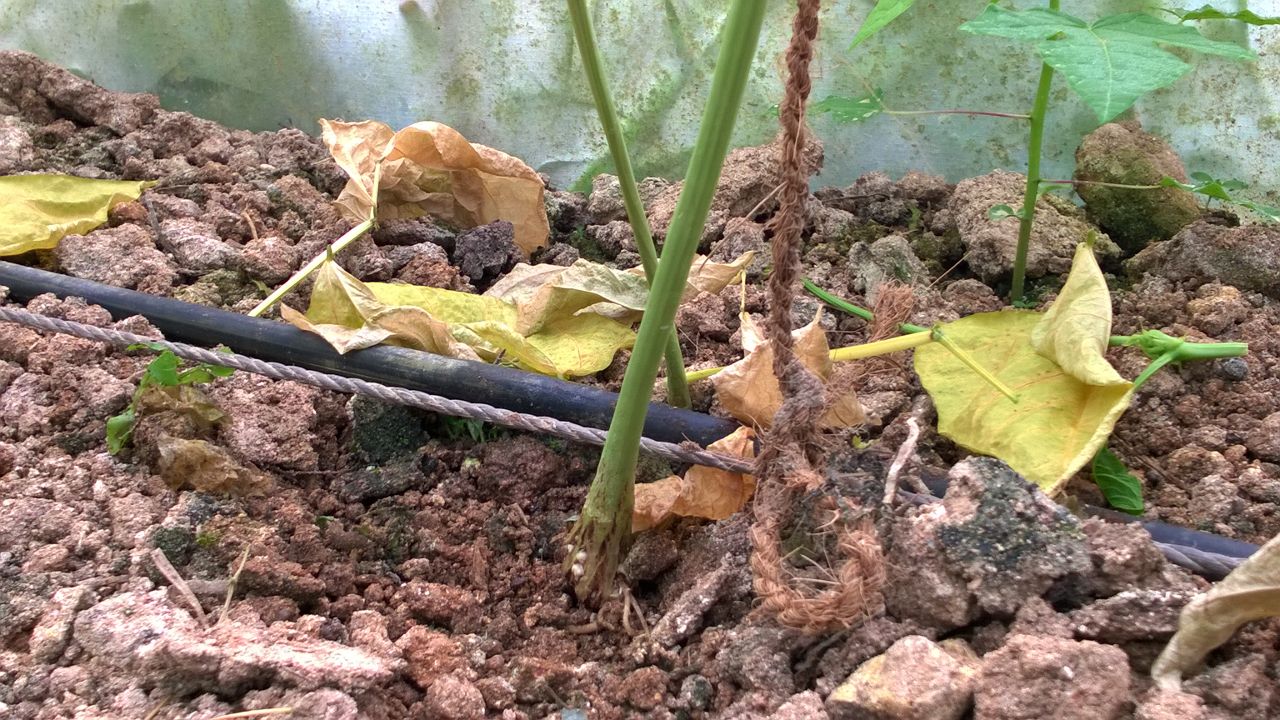
|
Importance of the
problem |
Fusarium wilt is a persistent soil-borne disease in cowpea that causes yellowing, wilting, and death of plants, often resulting in complete crop failure in infested fields. |
|
Common signs and
symptoms |
- Yellowing of lower leaves followed by wilting
- One-sided wilting or yellowing on the plant
- Brown streaks in vascular tissues of stems
- Stunted growth and poor flowering
- Sudden collapse of plants at flowering stage
|
|
Problems with similar
symptoms |
- Root Rots (Pythium/Rhizoctonia) – Both cause root damage and wilting
- Drought Stress – May cause wilting without visible root symptoms
- Nematode Infestation – Galling and root damage may confuse with wilt symptoms
|
|
Causal organism and
their spread |
Caused by Fusarium oxysporum f. sp. tracheiphilum, a fungus that survives in soil and plant residues. It spreads through infected seed, irrigation water, tools, and wind-blown soil. |
|
Mechanism of damage |
The fungus invades roots and blocks the xylem vessels, restricting water and nutrient transport. This leads to wilting, leaf chlorosis, and plant death, especially under warm conditions. |
|
Ideal management
strategy |
- Use resistant or tolerant cowpea varieties
- Practice 2–3 year crop rotation with non-hosts
- Remove and destroy infected plant residues
- Apply well-rotted compost to improve soil health
- Fungicide: Carbendazim 50% WP at 1 g/liter water as soil drench
- Fungicide: Trichoderma viride (bio-agent) at 10 g/kg seed treatment
|
|
References |
1. ICAR-IIPR Pulse Disease Management Manual.
2. CIBRC India – Fungicide and Bio-agent Use Recommendations.
|
Root Rots (Pythium spp., Rhizoctonia spp.)

|
Importance of the
problem |
Root rots are major seedling and vegetative stage diseases in cowpea, especially under poorly drained or over-irrigated soils, leading to seedling death and yield losses. |
|
Common signs and
symptoms |
- Seedling damping-off after emergence
- Brown to black root discoloration and decay
- Stunted plants with yellowing leaves
- Wilting during hot parts of the day
- Reduced root mass with poor nodulation
|
|
Problems with similar
symptoms |
- Fusarium Wilt – Both cause root browning and plant wilting
- Water Logging – Suffocation leads to similar root decay
- Drought Stress – Wilting may occur but roots appear healthy
|
|
Causal organism and
their spread |
Caused by Pythium spp. (oomycetes) and Rhizoctonia solani (fungus), which persist in soil and plant debris. They spread through contaminated water, tools, and infected seed. |
|
Mechanism of damage |
These pathogens attack the roots and collar region, killing root tips and compromising water and nutrient uptake. This leads to poor establishment, stunting, and eventual plant death. |
|
Ideal management
strategy |
- Ensure proper field drainage and avoid waterlogging
- Treat seed with Trichoderma viride at 10 g/kg seed
- Practice crop rotation with cereals or non-hosts
- Avoid deep sowing and overwatering seedlings
- Fungicide: Metalaxyl 8% + Mancozeb 64% WP at 2 g/liter as soil drench
- Fungicide: Captan 50% WP at 2 g/kg seed for seed treatment
|
|
References |
1. ICAR-IIPR Disease Management in Legumes.
2. Kerala Agricultural University Plant Health Guidelines.
|
Cercospora Leaf Spot (Cercospora canescens)

|
Importance of the
problem |
Cercospora leaf spot is a common foliar disease in cowpea, especially in warm and humid regions. It reduces photosynthetic area and can cause significant yield loss if uncontrolled. |
|
Common signs and
symptoms |
- Small, circular to irregular brown leaf spots
- Spots may coalesce to form large necrotic areas
- Leaves may curl, yellow, and drop prematurely
- Severe defoliation late in the season
- Dark brown lesions can appear on stems and pods
|
|
Problems with similar
symptoms |
- Bacterial Blight – Both produce necrotic leaf spots
- Anthracnose – Can cause dark lesions on leaves and stems
- Nutrient Deficiencies (Potassium) – May show marginal spotting and browning
|
|
Causal organism and
their spread |
Caused by the fungus Cercospora canescens, which survives in infected crop debris and spreads through wind-borne spores and rain splash. |
|
Mechanism of damage |
The fungus infects leaf tissue, forming lesions that reduce the effective photosynthetic area. Premature leaf drop weakens the plant and reduces seed filling and quality. |
|
Ideal management
strategy |
- Use disease-free seed and resistant varieties
- Practice crop rotation and destroy crop residues
- Avoid overhead irrigation and overcrowding
- Ensure good field air circulation and drainage
- Fungicide: Mancozeb 75% WP at 2.5 g/liter water
- Fungicide: Chlorothalonil 75% WP at 2 g/liter water
|
|
References |
1. ICAR-Indian Institute of Pulses Research – Fungal Disease Guide.
|
Anthracnose Disease (Colletotrichum lindemuthianum)
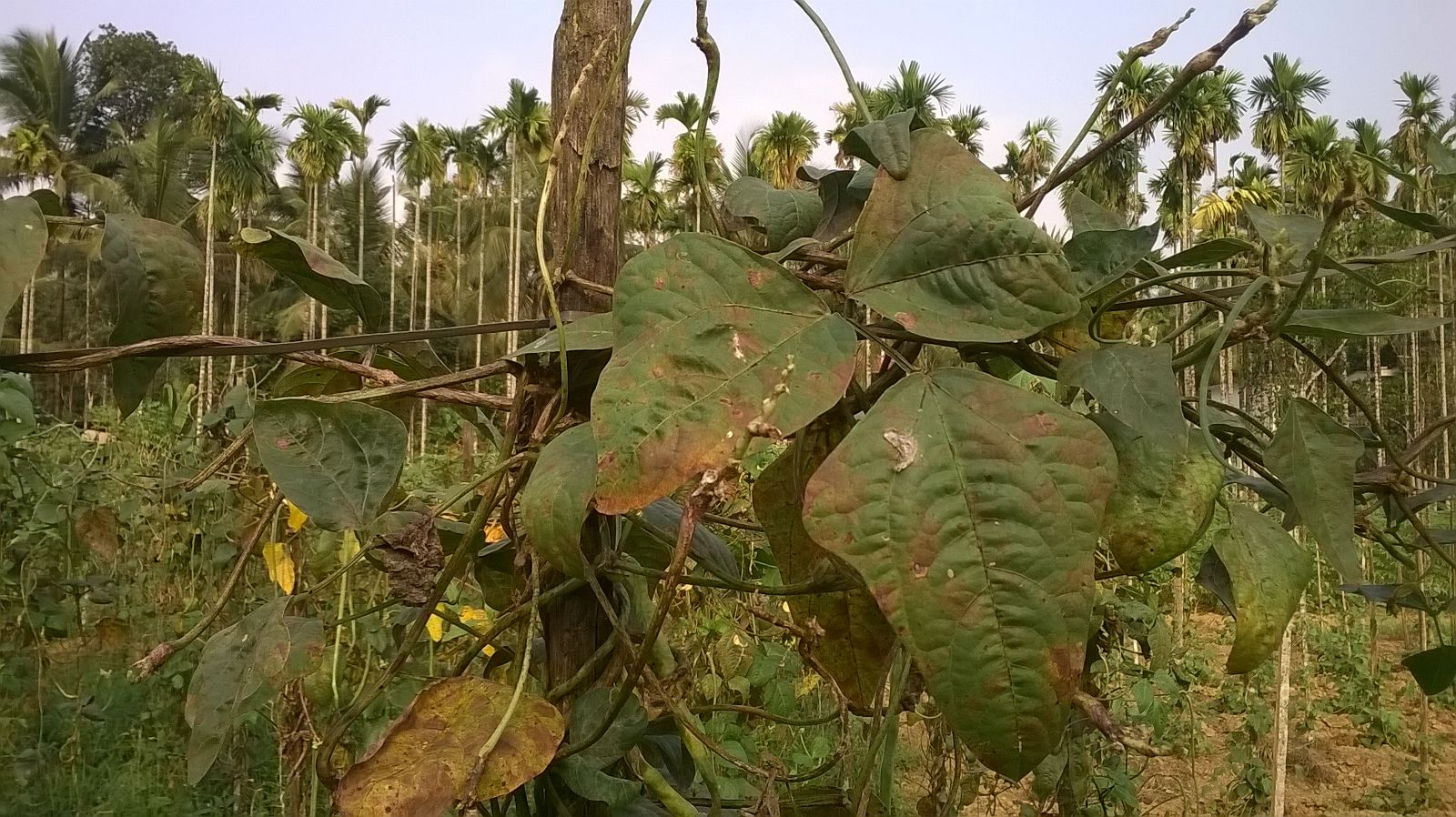
|
Importance of the
problem |
Anthracnose is a seed- and air-borne fungal disease that affects cowpea leaves, stems, and pods. It can cause heavy losses during cool, wet weather, especially in poorly managed fields. |
|
Common signs and
symptoms |
- Dark, sunken lesions on stems and petioles
- Circular brown to black spots on leaves
- Lesions with pinkish spore masses under humidity
- Pod lesions leading to seed discoloration
- Infected seedlings may die after emergence
|
|
Problems with similar
symptoms |
- Cercospora Leaf Spot – Both show brown leaf lesions
- Bacterial Blight – Can also cause dark, sunken lesions on pods
- Rust Disease – May resemble advanced anthracnose if pustules are missed
- Herbicide Injury – Can cause dark necrotic patches resembling lesions
|
|
Causal organism and
their spread |
Caused by Colletotrichum lindemuthianum. It spreads via infected seeds, wind-driven rain, and splashing irrigation. The pathogen also survives in crop debris. |
|
Mechanism of damage |
The fungus penetrates plant tissues and produces toxins that kill cells, resulting in sunken lesions. This affects nutrient transport, weakens plants, and reduces seed development and quality. |
|
Ideal management
strategy |
- Use certified disease-free and treated seed
- Remove and destroy infected crop residues
- Rotate with non-host crops for 2–3 seasons
- Avoid working in wet fields to reduce spread
- Fungicide: Carbendazim 50% WP at 1 g/liter water
- Fungicide: Mancozeb 75% WP at 2.5 g/liter water
|
|
References |
1. ICAR-IIPR Pulse Disease Compendium.
2. Kerala Agricultural University Disease Control Manual.
|
Rust Disease (Uromyces appendiculatus)

|
Importance of the
problem |
Rust is a widespread fungal disease of cowpea that thrives in moist, warm conditions. It reduces leaf area and plant vigor, leading to substantial yield and seed quality losses. |
|
Common signs and
symptoms |
- Small reddish-brown pustules on lower leaf surface
- Yellow spots appear on upper leaf surface
- Severely infected leaves become dry and fall
- Pustules may appear on stems and pods too
- General stunting and poor pod formation
|
|
Problems with similar
symptoms |
- Anthracnose – Can be mistaken for rust if pustules are missed
- Cercospora Leaf Spot – Brown spots may look like early rust infection
- Nutrient Deficiencies (Potassium) – Yellowing and spotting may confuse diagnosis
|
|
Causal organism and
their spread |
Caused by Uromyces appendiculatus, an obligate parasitic fungus. It spreads through wind-borne uredospores and survives on volunteer plants and crop debris. |
|
Mechanism of damage |
The fungus infects the leaf tissue and forms pustules that rupture the epidermis, reducing photosynthesis. Defoliation and pod damage lower overall plant productivity and seed weight. |
|
Ideal management
strategy |
- Grow rust-tolerant or resistant cowpea varieties
- Remove volunteer plants and destroy debris
- Avoid late sowing to escape peak rust period
- Ensure field sanitation and proper crop rotation
- Fungicide: Propiconazole 25% EC at 1 ml/liter water
- Fungicide: Mancozeb 75% WP at 2.5 g/liter water
|
|
References |
1. ICAR-IIPR Rust Disease Management in Legumes.
2. CIBRC Registered Fungicides for Rust Control.
|
Root Knot Nematode (Meloidogyne spp.)
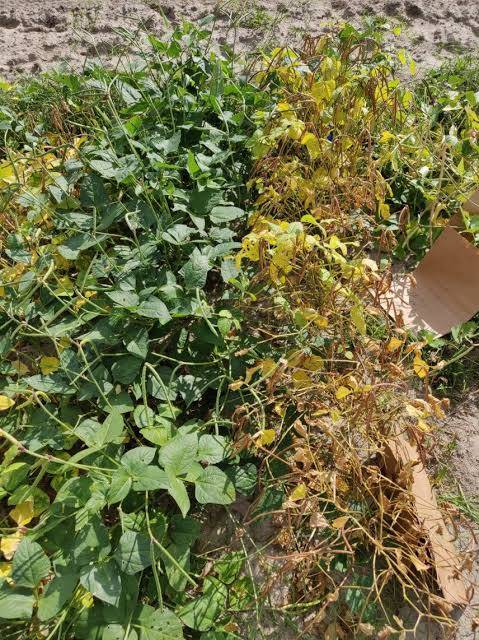
|
Importance of the
problem |
Root knot nematodes are microscopic pests that severely affect cowpea roots, leading to stunted growth, poor nutrient uptake, and considerable yield loss, especially in sandy or light soils. |
|
Common signs and
symptoms |
- Swollen galls or knots on roots
- Stunted growth with pale yellow leaves
- Wilting during hot periods despite moist soil
- Poor nodulation and weak root system
- Reduced flowering and pod formation
|
|
Problems with similar
symptoms |
- Fusarium Wilt – Causes wilting and stunting similar to nematode attack
- Root Rots – Both cause poor root development and stunted plants
- Nutrient Deficiency (Nitrogen) – General yellowing and poor growth may overlap
- Magnesium Deficiency – Interveinal yellowing and poor root absorption mimic stress symptoms
|
|
Causal organism and
their spread |
Caused by nematodes in the genus Meloidogyne (e.g., M. incognita, M. javanica). They spread through infested soil, irrigation water, contaminated tools, and infected plant material. |
|
Mechanism of damage |
Nematodes invade root tips and induce gall formation, disrupting water and nutrient absorption. This leads to physiological stress, poor plant vigor, and reduced crop yield. |
|
Ideal management
strategy |
- Practice crop rotation with cereals or non-hosts
- Use resistant or nematode-tolerant cowpea varieties
- Apply neem cake at 250 kg/ha during field prep
- Soil solarization before sowing in infested fields
- Nematicide: Carbofuran 3G at 1 kg a.i./ha (apply in furrow) – Banned
- Bio-agent: Paecilomyces lilacinus at 10 g/kg seed treatment
|
|
References |
1. ICAR-NBAIR Nematode Management in Pulses.
2. Kerala Agricultural University – Nematode Pest Guide.
|
Compact Soil (Soil Compaction)

|
Importance of the
problem |
Soil compaction restricts root penetration and air-water balance, leading to poor nutrient uptake and stunted growth. It reduces the effectiveness of irrigation and fertilizers, affecting cowpea yields. |
|
Common signs and
symptoms |
- Stunted growth with pale or yellow leaves
- Poor root development and shallow rooting
- Water stagnation or runoff after irrigation
- Hard, crusted surface layer after drying
- Uneven plant emergence or patchy growth
|
|
Problems with similar
symptoms |
- Root Rots – Both lead to poor root growth and wilting
- Drought Stress – Plants wilt due to poor water infiltration
- Nutrient Deficiency – Uptake problems may result in similar yellowing
- Root Knot Nematode – Stunted growth and poor root mass can be confused
|
|
Causal organism and
their spread |
Not caused by an organism. Compaction is due to repeated tillage, use of heavy machinery, low organic matter, or cultivation on wet soils. |
|
Mechanism of damage |
Compacted soils have fewer pore spaces, reducing air and water movement. This stresses roots, limits biological activity, and hinders root expansion and nutrient absorption. |
|
Ideal management
strategy |
- Avoid plowing or tilling when soil is wet
- Practice deep tillage or subsoiling every few seasons
- Add organic matter like compost or green manure
- Use cover crops to improve soil structure
- Apply gypsum if compaction is linked to sodium
- Rotate crops with taproot species to break hardpan
|
|
References |
1. ICAR-IISS Soil Health Management Guide.
2. Kerala Agricultural University Soil Conservation Handbook.
|







